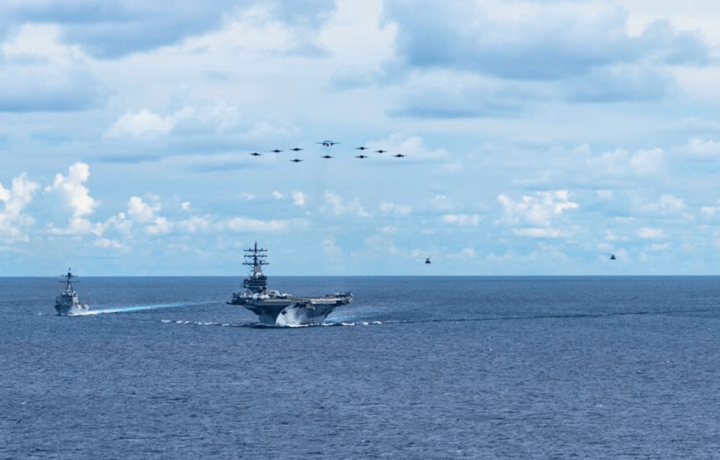The oldest operational nuclear-powered supercarrier may be on what is likely her final deployment, but it isn’t a sunset cruise by any means for the United States Navy’s USS Nimitz (CVN-68). The carrier has been operating in the highly contested South China Sea.
The warship, the lead vessel of the Navy’s class of supercarriers, has been in service for more than five decades and is scheduled for retirement in May 2026.
Final Deployment – Going Out Big!
CVN-68 departed from Naval Base Kitsap-Bremerton, Wash., in March and, following a scheduled port visit to Guam in April, spent last month in the Philippine Sea before transiting to the adjacent South China Sea. While operating in the waters of the Western Pacific, the flattop and her strike group have been conducting both day and night flight evolutions, showcasing the carrier air wing’s ability to launch and recover aircraft in a variety of conditions rapidly, the U.S. Navy previously announced.
Such activities are meant to support maritime security and ensure the U.S. Navy maintains the combat readiness to project power across the theater.
The Nimitz Carrier Strike Group (NIMCSG) consists of the flagship aircraft carrier USS Nimitz, Carrier Air Wing 17 (CVW-17), and Destroyer Squadron (COMDESRON) 9.
Not Middle East Bound
This is now the carrier’s second time in the South China Sea during this deployment, having sailed through the Strait of Malacca, the vital waterway that links the South China Sea with the Indian Ocean. That had led to speculation that the carrier could head to the Middle East to support the U.S. Navy’s ongoing operations in the region, where it had been confronting the Iranian-backed Houthi militants in Yemen for more than a year and a half.
The Pentagon has rotated multiple carriers to the Red Sea and Gulf of Aden since October 2023, when Hamas, another regional group with ties to Tehran, carried out a terrorist attack in southern Israel. After the Israeli Defense Forces launched an invasion of Gaza to destroy Hamas, the Houthis began to target commercial shipping in the Suez Canal and the Red Sea in response. The U.S. Navy has maintained a presence since.
However, as Washington was able to reach a ceasefire with the group, a decision was likely made to send CVN-68 back to the South China Sea instead. In late May, the carrier made a port call at Malaysia’s Port Klang, marking its first visit to a foreign port and the second port call of the deployment, following its previous stop in Guam.
The carrier has since returned to the U.S. 7th Fleet’s area of operations in the waters where Beijing continues to assert its territorial claims. That has led to confrontations with its other nations, notably the Philippines, a major U.S. ally protected by a mutual defense treaty, Newsweek reported.
There has been speculation that the USS Nimitz could join forces with her sister carrier, the USS George Washington (CVN-73), the U.S. Navy’s only forward-deployed carrier, based in Yokosuka, Japan, and the amphibious assault ship USS America (LHA-6) in the Western Pacific for joint operations.
LHA-6, also based in Japan, has also been operating in the Philippine Sea. It can carry the Lockheed Martin F-35B Lightning II, the short takeoff and vertical landing (STOVL) variant of the Joint Strike Fighter, enabling it to operate as a light aircraft carrier.
Heading to Norfolk Next Year
It is expected that, upon completion of this deployment, USS Nimitz will head to Norfolk, VA, for her planned decommissioning process. While there have been calls to save the historic vessel as a floating museum, it would likely be impossible to remove its nuclear reactor. In addition, it is unlikely that the U.S. Navy would want “tourists” to gather any insight into the layout of the carrier that could compromise the remaining nine Nimitz-class carriers in service, as many of the design elements are similar to those of the new Gerald R. Ford class.
After the nuclear reactor is removed, any remaining parts from the retired carrier determined to be salvageable will be used on other carriers, including her sister carriers and the Gerald R. Ford-class flattops now being constructed.
The lead vessel and class of carriers were named to honor United States Fleet Admiral Chester W. Nimitz, who commanded the U.S. Pacific Fleet during the Second World War. The nuclear-powered class of supercarriers was developed in the 1960s to supplement the U.S. Navy’s Kitty Hawk and Enterprise classes, initially designed as direct replacements for the aging Midway-class.
A total of nine additional Nimitz-class carriers were built, with the last of the class, USS George H.W. Bush (CVN 77), commissioned in January 2009. Current plans call for the oldest of the Nimitz class to be replaced on a one-for-one basis with the Gerald R. Ford-class of carriers over the next three decades, with the USS Dwight D. Eisenhower (CVN-69) next in line. That carrier could be retired as early as 2029.



